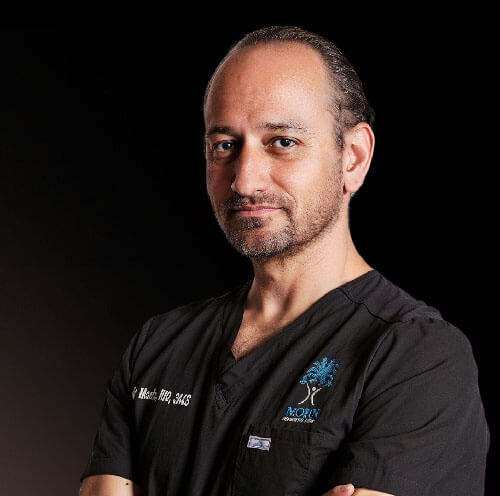
The duodenal switch (biliopancreatic diversion with duodenal switch (BPD-DS) is a rare bariatric surgery performed by Gastric Bypass Surgeons. It is reserved for “super obese” patients with body mass index (BMI) scores of 50 or greater.
One of the reasons the technique is so rarely performed is because it used to be associated with a high amount of adverse effects.
Thanks to advances in laparoscopic surgery and other bariatric techniques, the duodenal switch is safe and effective for morbid obesity.
The procedure is also the most effective out of all other weight-loss surgeries at treating obesity comorbidities like type 2 diabetes, heart disease, and others.
Keep reading if you suffer from morbid obesity and you feel this bariatric surgery might be right for you.
What is a Duodenal Switch and How Does it Work?
The surgeon performs duodenal switch surgery in two phases. Some surgeons choose to do them during a single session while others will separate them into their unique appointments.
Phase 1
During a duodenal switch, the bariatric surgeon removes 80% to 85% of the stomach. The surgeon will only remove the upper, stretchy part of your stomach. This is the same technique used in gastric sleeve and Roux-en-Y gastric bypass surgery. The remaining portion of your stomach, which looks like a vertically oriented tube, is configured into a small pouch.

You don’t notice these changes because the structural elements of your stomach are preserved, including the nerves that control normal stomach function.
To illustrate the changes to your stomach, you can imagine reducing your capacity for food from 1,000 ml (1 quart) to 4-6 ounces (120-180 ml). This will allow you to eat approximately 4-6 ounces of solid food before feeling full.
The reason for these changes is to force you to eat less food. One of the perks of the duodenal switch is that your stomach is larger than it would be for other bariatric surgeries. You’ll eat less, but you can still enjoy somewhat normal-sized meals.
Phase 2
The surgeon then connects the smaller stomach pouch to a portion of the small intestine. This is similar to the technique used during gastric bypass surgery.
However, instead of attaching the smaller stomach to the small intestine (which is how it’s done during gastric bypass), the stomach is attached to the duodenum (the first portion of the small intestine). This limits the number of calories your body can absorb from the foods you eat.
There’s another perk of the duodenal switch you should know about. Because the pylorus (a passageway between the stomach and upper small intestine (duodenum)) is preserved, you are unlikely to experience “dumping syndrome” which is sometimes associated with other bariatric surgeries.
What is Dumping Syndrome?
Dumping syndrome is the rapid movement of food through the digestive tract. The syndrome triggers symptoms like nausea, sweating, and diarrhea.
The changes to your digestive system are performed using a variety of devices, including laparoscopic tools, robotic surgery, and magnets to reduce the number of incisions needed.
This makes the duodenal switch minimally invasive, which shortens your hospital stay (recovery typically lasts a day or two). It leaves minuscule scars and fosters a faster recovery time with minimal discomfort.
Is Duodenal Switch Effective for Weight Loss?

Duodenal switch can help you lose up to 70% to 100% of your excess weight over the long term. In addition to restricting the amount of food you eat and controlling the amount of food your body can absorb, the duodenal switch also has hormonal effects.
The removal of the upper part of your stomach decreases the level of ghrelin (the hunger hormone) in your body. With the production of less ghrelin, you feel less hungry overall.
Further, bypassing the upper intestine helps deliver food to the lowest portion of the small intestine earlier than usual. This causes your body to release appetite-suppressing hormones like polypeptide YY (PYY) and peptide 1 (GLP1). The result is significant and long-term weight loss, as well as weight maintenance, and diabetes resolution.
Who is a Good Candidate for Duodenal Switch Surgery?
To qualify for bariatric surgery of any type, you must be healthy enough to undergo surgery. Bariatric surgeons reject patients for surgery who don’t meet specific health benchmarks.
You would not be a good candidate if you have gastrointestinal disorders, cardiovascular disease, severe pulmonary disease, or an autoimmune disease.
You would also be barred from surgery if you are pregnant, have an increased risk of bleeding, or have been diagnosed with a mental disorder.
When it comes to duodenal switch surgery, and assuming you are generally healthy, you would be a good candidate if your BMI is 40 or greater. However, since the duodenal switch is an excellent surgical option for people suffering from extreme obesity, patients with BMIs of 55 or greater tend to receive the most benefit from this type of bariatric surgery.
You can also have a BMI of 40 and above with one or more comorbidities such as type 2 diabetes, hypertension, sleep apnea, heart disease, and severe hyperlipidemia (high blood fat content).
A duodenal switch can treat the excess weight gain and these extra comorbidities, potentially adding years to your life.
You must also be eighteen years of age or older with a health history that includes attempts to lose weight through non-surgical means.
You must also have a commitment to adopting healthy lifestyle habits like healthier eating and regular exercise.
Are You Severely Obese?

According to the Centers for Disease Control and Prevention (CDC), around 42% of all US adults are obese.
Obesity is a medical term that indicates a disease consisting of excessive body fat that can increase the risk of developing health problems.
Obesity is typically caused by the consumption of more calories than are burned during normal daily activities and exercise.
Doctors identify obesity by measuring a patient’s body mass index (BMI).
Body mass index is a measurement consisting of your body fat based on your height and weight.
The U.S. Department of Health and Human Services offers a free BMI calculator. It can help you determine if you might be right for the duodenal switch.
According to the BMI scale, patients under 18.5 BMI are underweight.
Normal weight is anywhere between 18.5 and 24.9 BMI.
Overweight is 25 to 29.9 BMI.
When your BMI is 30 or greater, you seem to be suffering from the disease of obesity.
We define Super obesity as a BMI of 50 or greater. Another term for this is morbid obesity.
The duodenal switch is reserved for the morbidly obese. If your BMI is 50 or greater or 40 with obesity comorbidities present, you could be an excellent candidate for the duodenal switch.
What are the Results of Duodenal Switch Surgery?
Knowing what to expect from your bariatric surgery is an important part of deciding if the duodenal switch is right for you. Everyone is different, but the overall success rate for this particular procedure is good (80%). The satisfaction rate for duodenal switch surgery is 95%.
Your bariatric surgeon will give you guidelines to follow to maximize your weight loss. You can expect to see a 60% loss of excess weight within the first year.
Your weight loss should then progress to 75% of your excess weight in the second year.
This amounts to remarkable weight loss success after the duodenal switch. Some patients end up losing more while others lose less. Once again, everyone is different, and some people respond more favorably to duodenal switch surgery than others.
However, not only does the duodenal switch help with significant weight loss, but the surgery offers a significant comorbidity reduction in as little as a year after surgery.
For long-term success with a duodenal switch, we advise scheduling follow-up appointments with your surgeon. These meetings are critical for assessing your progress. Your doctor may order blood work and labs to identify potential nutritional deficiencies, which can occur with this surgery. Your doctor will check your vitamin B12 levels, as well as your levels of Folate, iron, and red blood cells. Maintaining long-term aftercare is the best way to enjoy long-term and safe success with the duodenal switch.
Understanding the Benefits and Risks of Duodenal Switch

Before undergoing any type of surgery, make sure you have a good understanding of what to expect. Your bariatric surgeon will discuss the positives and any negatives of surgery before scheduling you for a duodenal switch procedure. This will help you establish realistic expectations for the surgery and the recovery process, as well as the results you can expect after your body has healed.
The benefits of the duodenal switch include reduced cardiovascular risk, a greater quality of life, and potentially longer life.
Little-known benefits of the procedure include a larger stomach than you would have with other surgeries and a lower risk of developing marginal ulcers compared to Roux-en-Y gastric bypass patients.
The duodenal switch also reduces fat absorption by 70% or more.
As far as risks go, all surgeries come with risks. Duodenal switch surgery is the most likely to cause surgery-related problems and nutritional deficiencies. Duodenal switch reduces your body’s capacity for essential vitamin and mineral absorption. If not managed, this can lead to long-term complications, including kidney stones, iron and calcium deficiencies, anemia, and osteoporosis. This is why aftercare by your bariatric surgeon is critical for success.
Your bariatric surgeon may recommend supplementation with a multivitamin and nutrients like iron and calcium. They will keep your body at acceptable levels.
Other potential risks of surgery include infection, internal bleeding, hernias, blood clots, and death.
Establishing Realistic Expectations About Your Results and Life Changes
We encourage you to keep realistic expectations about the results you want to achieve, and the lifestyle you will have to live after the duodenal switch.
Your life won’t quite be the same after surgery, but that is not a bad thing. To be successful with this weight loss surgery, you must learn to eat right, exercise, and live with health in mind at all times. Keep at it and you’ll see that a healthy lifestyle is not only fun and exciting, but it makes you feel good too.
After your recovery, which can take three or four weeks, you will have to commit to healthier lifestyle habits.
In the immediate days after duodenal switch surgery, your diet will consist of liquids such as protein shakes and light broths. Your bariatric surgeon will monitor your progress as you incorporate pureed food into your routine, and eventually solid foods. You must introduce normal foods slowly to give your body time to adjust to the digestive changes that took place during your procedure.
The American Society for Metabolic and Bariatric Surgery (ASMBS) recommends eating small but nutritious meals. Avoid sugar and keep to meals high in protein, omega-3 fatty acids, whole grains, vegetables, and fruits.
In addition to eating healthily, regular exercise is key to maintaining a healthy lifestyle and keeping the weight off after the duodenal switch.
How Much Does Duodenal Switch Cost?
Duodenal switch costs around $20,000. Some insurance companies may look at the duodenal switch as an experimental procedure. However, some policies will cover it. Check with your insurance provider to see if they cover this bariatric surgery under your current policy.
Is Duodenal Switch Weight Loss Surgery Right for You?
Surgeons usually perform duodenal switch surgery on patients who have had an unsuccessful Lap-Band procedure. Lap-Band or gastric banding involves the surgeon wrapping a prosthetic device around the stomach, which restricts the amount of food you can eat. The Lap-Band can slip or loosen. This increases the likelihood of you requiring a follow-up surgery such as the duodenal switch.
While in the past, the duodenal switch has been considered the bariatric surgery with the highest long-term complication rates, modern post-operative care, and minimally-invasive approaches have improved complication rates for this procedure.
If you feel the duodenal switch might be right for you, or you want to keep your options open. Ask about the gastric sleeve and gastric bypass as possibilities, schedule a consultation today. Call Healthy Life Bariatrics to meet with Dr. Babak Moeinolmolki in Los Angeles, California. You can reach us at: (310)861-7844.

